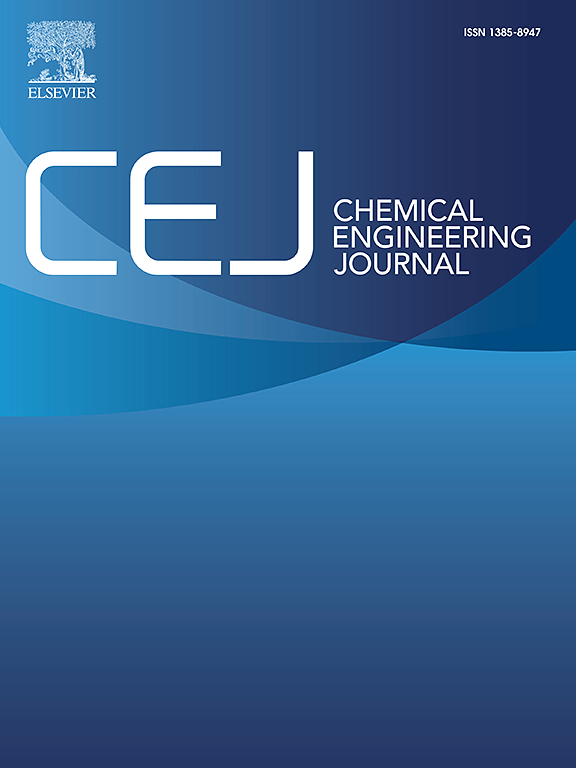Multi-level metalized PBO composite fabric for polar extreme environments: integrating electromagnetic protection, stable electric thermal conversion, and high-strength
IF 13.2
1区 工程技术
Q1 ENGINEERING, CHEMICAL
引用次数: 0
Abstract
Polar scientific research equipment in extreme low-temperature and strong electromagnetic interference (EMI) environments imposes multiple stringent requirements on the electromagnetic protection, active thermal management, and structural reliability of materials. Fibrous fabric materials with metal-functionalized surfaces have great potential for application in polar scientific research. In this work, a multifunctional PBO@Ni@Cu (poly-p-phenylene benzobisoxazole@Ni@Cu) composite fabric was developed. The composite was based on PBO fibers, through optimized sequential electroless nickel plating and copper electroplating processes for depositing Ni and Cu layers. Remarkably, the tensile strength of PBO@Ni@Cu remained at 5.16 GPa. The resulting material exhibited an excellent electromagnetic shielding performance of 59.57 dB in the X-band and achieved stable surface Joule heating at 195 °C under an applied voltage of 2 V. To address its high reflectivity, annealing combined with polydimethylsiloxane coating treatment was implemented, increasing the absorption coefficient to 0.35 while maintaining an effective shielding performance of 43.74 dB, which significantly reduced secondary EMI reflections. Notably, in polar environments, this composite not only shields unmanned aerial vehicle components from electromagnetic waves but also facilitates deicing/anti-icing functions of rotor blades through electro-thermal conversion, thereby ensuring flight stability. Additionally, PBO@Ni@Cu provides stable electromagnetic protection and body temperature maintenance for polar researchers working outdoors. This study provides a multifunctional material solution for multi-scenario applications in high-cold and strong electromagnetic interference environments.

极地极端环境多级金属化PBO复合织物:集电磁防护、稳定电热转换、高强度于一体
极地科考设备在极低温和强电磁干扰环境下工作,对材料的电磁防护、主动热管理和结构可靠性提出了多重严格的要求。具有金属功能化表面的纤维织物材料在极地科学研究中具有很大的应用潜力。在这项工作中,开发了一种多功能PBO@Ni@Cu(聚对苯benzobisoxazole@Ni@Cu)复合织物。该复合材料以PBO纤维为基体,通过优化的顺序化学镀镍和电镀铜工艺沉积Ni和Cu层。值得注意的是,PBO@Ni@Cu的抗拉强度保持在5.16 GPa。该材料在x波段表现出59.57 dB的优异电磁屏蔽性能,并在2 V的电压下在195 °C下实现了稳定的表面焦耳加热。为了解决其高反射率问题,采用退火结合聚二甲基硅氧烷涂层处理,将吸收系数提高到0.35,同时保持43.74 dB的有效屏蔽性能,显著降低了二次EMI反射。值得注意的是,在极地环境中,该复合材料不仅可以屏蔽无人机部件免受电磁波的影响,还可以通过电热转换促进旋翼叶片的除冰/防冰功能,从而确保飞行稳定性。此外,PBO@Ni@Cu为户外工作的极地研究人员提供稳定的电磁保护和体温维持。该研究为高寒强电磁干扰环境下的多场景应用提供了多功能材料解决方案。
本文章由计算机程序翻译,如有差异,请以英文原文为准。
求助全文
约1分钟内获得全文
求助全文
来源期刊

Chemical Engineering Journal
工程技术-工程:化工
CiteScore
21.70
自引率
9.30%
发文量
6781
审稿时长
2.4 months
期刊介绍:
The Chemical Engineering Journal is an international research journal that invites contributions of original and novel fundamental research. It aims to provide an international platform for presenting original fundamental research, interpretative reviews, and discussions on new developments in chemical engineering. The journal welcomes papers that describe novel theory and its practical application, as well as those that demonstrate the transfer of techniques from other disciplines. It also welcomes reports on carefully conducted experimental work that is soundly interpreted. The main focus of the journal is on original and rigorous research results that have broad significance. The Catalysis section within the Chemical Engineering Journal focuses specifically on Experimental and Theoretical studies in the fields of heterogeneous catalysis, molecular catalysis, and biocatalysis. These studies have industrial impact on various sectors such as chemicals, energy, materials, foods, healthcare, and environmental protection.
 求助内容:
求助内容: 应助结果提醒方式:
应助结果提醒方式:


